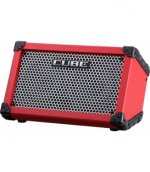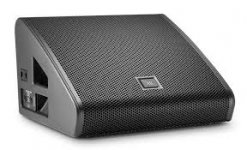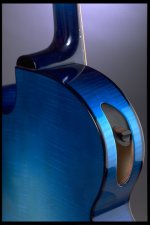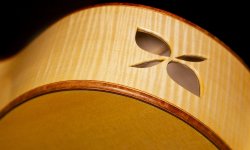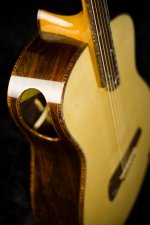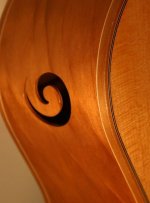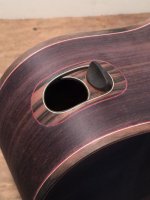So this does not have much use?
I think I do not understand well .....
Haha! I have one of those; it's not what you think, it's an imitation PA monitor for game consoles.
BTW, they do make monitor type guitar amps, targeted at buskers.
Do you ever listen critically to your home Hi-Fi that way, with your back to the speakers? So much midrange and treble is lost. Sure, you can "hear" the music, but half of the detail is gone.
Maybe the audience doesn't care - but every good musician does care, a great deal, about how his/her instrument sounds. Musicians spend enormous amounts of time, hard work, and money, trying to improve their tone even the tiniest little bit. Then guitarists throw much of it away, by being unable to hear themselves properly.
An e-guitar is more capable of abuse than a violin - the e-guitar can make so much harsh treble that it hurts the audience's ears, and frequently that is the case at small live gigs. I think this is partly because the guitarist can't hear himself properly, since the amp is usually on the floor behind him.
You speak of monitoring for the guitarist being common - yet I have never seen it except at a very big gig. The live acts I see are usually no more than two, three or four musicians at a restaurant, wedding, or other small venue - and the guitarist never has monitoring, and usually has the amp behind him, and usually has too-bright tone, and is too loud for the mix.
But I think I'm increasingly off-topic for this thread, so enough from me.
-Gnobuddy
It seems fine, let's leave this OT, although it's interesting ... I think we're saying the same thing but the language plays a trick on us, I can not write directly in English, I do not know about you, maybe you also use the translator.
I'm not a musician, but I understand what you want to say. My two sons have their electric guitars and their amplifiers (Crate, something modest, SS) and when they lived here, I perceived how different the sound comes out directly, it is not the same as in a recording!
I agree with that point.
I like all kinds of music, I attend concerts of piano, symphonic music, rock, etc.
But yes, in big scenarios. What I really believed is that the guitarist listens to himself with the monitor in front of him, watch the 3.30 minute. That monitor is not direct towards the guitarist? You say it's not like that?
I was there, the general sound towards the room was radiated by two array lines hanging from the ceiling. That's part of the fixed installation, the musicians carry their own amplifiers, guitars and monitors.
Well, it's all for me too, friend.
YouTube
Haha! I have one of those; it's not what you think, it's an imitation PA monitor for game consoles.
BTW, they do make monitor type guitar amps, targeted at buskers.
It was the first appropriate image that I found ........ some of these others would be fine ?
Attachments
Electric guitar is hardly the first instrument intended to be listened to other than directly on-axis, violin being another excellent example. I'd be interested to see what happened if someone told a real French horn player to take his fist out of the bell so we can hear what it's "supposed to sound like."
I spent a great deal of my 20's on one side or the other of the control room window, playing vintage guitars and amps on stages, and repairing same for working musicians - occasionally even for major acts. As I said, I've been thoroughly indoctrinated in the orthodoxy, but I would say that your idea of hearing the amplifier properly differs from the electric guitarists with whom I have come into contact. I also find the idea that Eric Johnson, who claims to prefer the sound of carbon-zinc batteries in his TS-808 instead of alkalines, listens to his amplifiers without a monitor because he doesn't know better to be a bit... well, I'm looking for a good word here.
I spent a great deal of my 20's on one side or the other of the control room window, playing vintage guitars and amps on stages, and repairing same for working musicians - occasionally even for major acts. As I said, I've been thoroughly indoctrinated in the orthodoxy, but I would say that your idea of hearing the amplifier properly differs from the electric guitarists with whom I have come into contact. I also find the idea that Eric Johnson, who claims to prefer the sound of carbon-zinc batteries in his TS-808 instead of alkalines, listens to his amplifiers without a monitor because he doesn't know better to be a bit... well, I'm looking for a good word here.
Acoustic singers never listen from in front of their instrument.
French horn players throw their sound behind. Bagpipers walk away from their sound.
An in-your-face monitor makes sense for ONE person. Or perhaps several. But not a 1,000 head crowd.
Singers and guitarists "should" learn to listen to the ROOM. The reverberant field is pretty consistent all over, which means every paying customer. The nature of a large cone forces a rising treble on-axis to get flat average power to the room.
The reverberant field starts 4' out in a home, 11' out in a concert hall. (Low-ceiling over-crowded dives may not have a uniform field; but nobody is sober enough to care.)
That photo of Mr Johnson appears to be close-up of a largish stage. Say 8' Dc. However he is way off-axis to most of his "many" speakers. He has carefully selected a position where he can focus on either the ROOM or the AMP- they are nearly equal power and 2-ear hearing can select one or the other.
French horn players throw their sound behind. Bagpipers walk away from their sound.
An in-your-face monitor makes sense for ONE person. Or perhaps several. But not a 1,000 head crowd.
Singers and guitarists "should" learn to listen to the ROOM. The reverberant field is pretty consistent all over, which means every paying customer. The nature of a large cone forces a rising treble on-axis to get flat average power to the room.
The reverberant field starts 4' out in a home, 11' out in a concert hall. (Low-ceiling over-crowded dives may not have a uniform field; but nobody is sober enough to care.)
That photo of Mr Johnson appears to be close-up of a largish stage. Say 8' Dc. However he is way off-axis to most of his "many" speakers. He has carefully selected a position where he can focus on either the ROOM or the AMP- they are nearly equal power and 2-ear hearing can select one or the other.
Please re-read my previous post, because you have completely and utterly failed to understand it. I'm very far from suggesting that a great musician whose skills I am in awe of is ignorant or incompetent....Eric Johnson...doesn't know better...
Imagine a painter who spends twenty years wearing blue-tinted glasses, and learning to paint natural-looking colours in spite of the tinted glasses. Would she want to have the glasses removed after that, and risk losing decades of carefully honed colour skills - which will fall apart if the blue tint no longer affects what she sees?
Eric Johnson learned to produce ethereally beautiful sounds with his amp placed behind him, where he couldn't hear it properly. Would he risk throwing away all that experience?
-Gnobuddy
Have you seen the numerous newer models of acoustic guitars that place the sound-hole on top (on the curved sidewall), so that the player can hear her/himself better? Acoustic guitarists have finally begun to wise-up to the fact that they haven't been hearing their own guitar tone, not the way the audience does.Acoustic singers never listen from in front of their instrument.
When I play plugged-in (electro-)acoustic guitar, I aim the wedge-shaped acoustic guitar back at myself; the only way I can produce the best tone. I used to use a second identical wedge monitor facing the audience, but left it behind in the move to BC.
Yes, for the musician himself/herself, so that he/she can produce the best possible tone and playing. You cannot play as well if you cannot hear yourself.An in-your-face monitor makes sense for ONE person.
You know the joke about how every musician wants herself louder than everyone else in the mix?Singers and guitarists "should" learn to listen to the ROOM.
It used to be a joke because it was impossible fifty years ago. Then stages started sprouting more floor monitors with more sub-mixes. Eventually, it got to where, with big-name bands at any rate, nearly every member gets their own sub-mix, right in their own in-ear monitors.
When did it get to be controversial to consider that a musician might need to hear him/herself well?
-Gnobuddy
Attachments
When I first saw the picture I thought that it's about preamp tube being too close to the OT.
Probably the manufacturer wanted to "balance" the weight placing the power and output transformers at the ends of the chassis, being a "hanging" amplifier
Here's an idea; contact Basler Electric (who has made many many thousands of transformers for Peavey Electronics and everybody else in the industry) and criticise THEM for their manufacturing methods.They have only been in business since the 1940's,and perhaps their engineers (you know,the people who actually have certifications attesting to their understanding of these things) could take the time to explain to you what you can't seem to grasp on your own,despite the ongoing assistance of the members of this forum.Oh,and perhaps you could review a few of the patents these folks hold.
Don't forget to shake your head while you're at it
Basler Electric - Providing quality electrical products and service to customers throughout the world
Patents Assigned to Basler Electric Company - Justia Patents Search
Don't forget to shake your head while you're at it
Basler Electric - Providing quality electrical products and service to customers throughout the world
Patents Assigned to Basler Electric Company - Justia Patents Search
Welding laminations has not been easy, as per 1973:
https://patentimages.storage.googleapis.com/eb/85/48/27f8a2902cffe8/US3866014.pdf
ABB show up in 1990:
https://patentimages.storage.googleapis.com/ae/27/cc/ee3a1ad3f98715/US4899122.pdf
Just piping a Japanese patent (JP,04-099817,U1(1992)).
https://patentimages.storage.googleapis.com/eb/85/48/27f8a2902cffe8/US3866014.pdf
ABB show up in 1990:
https://patentimages.storage.googleapis.com/ae/27/cc/ee3a1ad3f98715/US4899122.pdf
Just piping a Japanese patent (JP,04-099817,U1(1992)).
The next page probably suggested wiping the laminations down with sperm-whale oil, or coating them in seal fat as an alternative....laminations could be insulated by dipping them in a flour and water mixture...
Materials science has brought us some amazing changes in the last several decades. Anyone remember reading in old science books about the use of "isinglass" any time a small clear window into some sort of scientific apparatus was needed?
-Gnobuddy
Now that transformer-related angst has been put to rest, perhaps it's time to address the bumblebee thing.We all remember learning that from an engineering point of view, bumblebees cannot fly.
Going back 90 years to 1930, our knowledge of fluid dynamics was minimal. The mathematical equations describing fluid flow were already known, but they were almost impossibly difficult to solve analytically by hand, except for some very simple cases, such as low-speed airflow around a perfect sphere. Even then, simplifying assumptions had to be made, such as treating air as though it had zero viscosity.
There were no computers powerful enough to do numerical solutions in 1930, so these mathematically (relatively) simple cases of fluid flow were all that we knew anything about.
In the early 1900s, two brilliant mathematicians named Martin Kutta and Nikolai Zhukovsky came up with a very clever method to solve the fluid flow equations for a certain class of long cylindrical bodies bodies (wings, in effect) moving uniformly through air of zero viscosity, without turbulence or flow separation. This was good enough to give a firm mathematical basis for airplane flight.
But, as it turns out, those simplified equations - which was all we had in 1930 - failed to explain the flight of insects, the bumblebee being one example. That simply meant that physicists and engineers had more left to learn - obviously bumblebee wings somehow generate much more lift than an equivalent size aeroplane wing.
Equally obviously, aeroplanes don't flap their wings, so the mathematics of aeroplane wings really didn't apply. But it was all we had at the time...and so in 1930, a French scientist who studied insects made the statement that bumblee bee flight was impossible according to aerodynamicists, engineers, and physicists.
Uneducated people love to mock those who are smarter and better educated, so the public leapt at this, and took it as evidence to support what they wanted to believe - that scientists and engineers were laughable fools who knew nothing. And so, the joke about the impossibility of bumblebee flight survives to this day, nearly a century later.
Science itself doesn't stand still, though. It was evident that insect flight used a different sort of fluid flow than aeroplane wings, and bits of the puzzle were unraveled slowly over the years.
About ten years ago, a Caltech scientist finally solved the entire problem, using high-speed cameras to capture actual bumblebee wing movements, then building a large robotic insect immersed in a giant vat of viscous fluid that let him study the fluid flow in great detail. You can read more about his work here: Explained: The Physics-Defying Flight of the Bumblebee
-Gnobuddy
As a mechanical engineer at an electronics company, I can definitively say this post is moronic. Get back to me, when any ME has that much sway in an EE heavy company. Thank you for the laugh. I see green horn engineers want to 'blame the other field', when older engineers are more diplomatic. Good luck!
There are ninety-seven posts before yours. It would help considerably if you specified which of them you were referring to....I can definitively say this post is moronic.
-Gnobuddy
when any ME has that much sway in an EE heavy company. Thank you for the laugh.
The ME's have a LOT of "sway" when you are building things that will be dropped, or otherwise be subjected to severe stress. When that same product has to be "trendy" then the ID (industrial design) people also have some serious say so.
As a mechanical engineer at an electronics company
I was an electrical engineer in an electronics company, Motorola, where we designed and built hand held two-way radios (walkie talkies) for police, fire and military use, as well as cell phones. One of the demos we did with our flagship walkie talkie was to run it over with a Ford Explorer, then pick it up and use it.
Every major product that came out of our building in it's last 10 years had three design teams, Electrical, Mechanical (about the same size) and Software (the largest).
I recently watched a documentary about Jaguar's development process for their first all-electric vehicle (the idiotically named i-Pace.)When that same product has to be "trendy" then the ID (industrial design) people also have some serious say so.
There mechanical design uses one motor on each axle, under the floor. The large lithium battery is also under the floor.
This gave the stylists an enormous amount of leeway, since they didn't have to worry about the awkwardly tall oil-pan-to-intake-manifold height of a normal internal combustion engine, nor the height and airflow requirements of the radiator needed to cool it.
So what did they do? Ian Callum, Jaguar's director of design, created a thick, bulky-looking vehicle with an huge blunt nose containing an enormous vertical grill, with, of course, no radiator behind it, just a blank wall.
In the film, the aerodynamicists say cautious things about how they had to work hard to improve the drag coefficient of this blobular beast with the barn-door nose, by doing things like creating an exit slot for air at the top, just behind the useless grille.
You hear no criticisms of the thick and lumpy shape of the vehicle, for obvious reasons; young aerodynamics engineers obviously wield a lot less power within the design team than the director of design himself.
But it doesn't take much reading between the lines to guess how the aero people feel about the task they've been given: to streamline a completely unnecessary vertical barn-door.
Remember, this is an all-electric vehicle: not only is it stupid to waste unnecessary kilowatts pushing air out of the piggy Jaguar's way, but a lousy drag coefficient also equals lousy range on a charge, or the need for an even bigger, heavier, and bulkier battery pack to mitigate the problem.
-Gnobuddy
Attachments
- Status
- This old topic is closed. If you want to reopen this topic, contact a moderator using the "Report Post" button.
- Home
- Live Sound
- Instruments and Amps
- The dumbest thing I've ever seen in amp construction....
